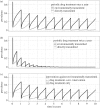Disease ecology, health and the environment: a framework to account for ecological and socio-economic drivers in the control of neglected tropical diseases
- PMID: 28438917
- PMCID: PMC5413876
- DOI: 10.1098/rstb.2016.0128
Disease ecology, health and the environment: a framework to account for ecological and socio-economic drivers in the control of neglected tropical diseases
Abstract
Reducing the burden of neglected tropical diseases (NTDs) is one of the key strategic targets advanced by the Sustainable Development Goals. Despite the unprecedented effort deployed for NTD elimination in the past decade, their control, mainly through drug administration, remains particularly challenging: persistent poverty and repeated exposure to pathogens embedded in the environment limit the efficacy of strategies focused exclusively on human treatment or medical care. Here, we present a simple modelling framework to illustrate the relative role of ecological and socio-economic drivers of environmentally transmitted parasites and pathogens. Through the analysis of system dynamics, we show that periodic drug treatments that lead to the elimination of directly transmitted diseases may fail to do so in the case of human pathogens with an environmental reservoir. Control of environmentally transmitted diseases can be more effective when human treatment is complemented with interventions targeting the environmental reservoir of the pathogen. We present mechanisms through which the environment can influence the dynamics of poverty via disease feedbacks. For illustration, we present the case studies of Buruli ulcer and schistosomiasis, two devastating waterborne NTDs for which control is particularly challenging.This article is part of the themed issue 'Conservation, biodiversity and infectious disease: scientific evidence and policy implications'.
Keywords: coupled ecological–economic systems; environmentally transmitted diseases; planetary health; sustainable disease control.
© 2017 The Author(s).
Conflict of interest statement
The authors declare no competing financial interests.
Figures






References
-
- Sachs J. 2001. Macroeconomics and health: investing in health for economic development. Report of the Commission on Macroeconomics and Health. Geneva, Switzerland: WHO.
-
- World Health Organization 2015. Investing to overcome the global impact of neglected tropical diseases: Third WHO report on neglected tropical diseases. Geneva, Switzerland: WHO.
MeSH terms
Grants and funding
LinkOut - more resources
Full Text Sources
Other Literature Sources
Medical
Molecular Biology Databases
Miscellaneous

